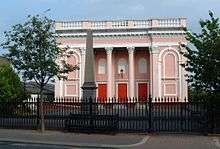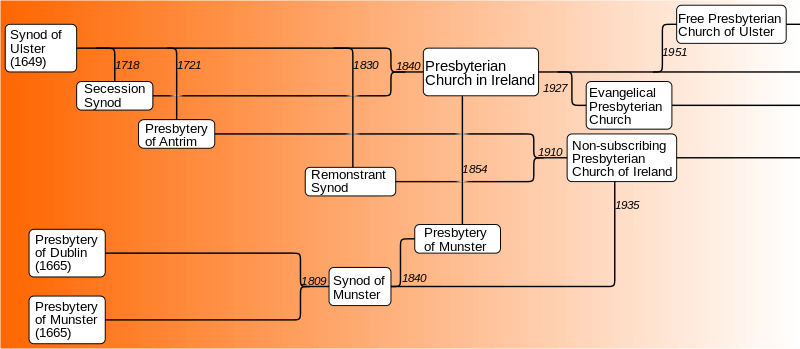Non-subscribing Presbyterian Church of Ireland
| Non-subscribing Presbyterian Church of Ireland | |
|---|---|
|
The official logo of the Non-subscribing Presbyterian Church of Ireland. | |
| Classification | Protestant |
| Orientation | Presbyterian/Liberal Christianity |
| Polity | Presbyterian |
| Associations | Irish Council of Churches, European Liberal Protestant Network, International Association for Religious Freedom |
| Region | Northern Ireland, Ireland |
| Origin | 1910 |
| Merger of | Presbytery of Antrim with Remonstrant Synod of Ulster |
| Congregations | 34 |
| Members | 4,000 |
| Official website | http://www.nspresbyterian.org/ |
The Non-subscribing Presbyterian Church of Ireland has its origins with those early 18th-century Presbyterian ministers who refused to subscribe at their ordination to the Westminster Confession, a standard Reformed (Calvinist) statement of faith; and who were placed, in 1725, the Presbytery of Antrim. A similar disagreement led to the creation of the Remonstrant Synod of Ulster in 1830. In 1835 the two bodies together with the Synod of Munster formed the Association of Irish Non-subscribing Presbyterians.[1]
The Non-subscribing Presbyterian Church of Ireland (NSPCI) was consolidated in 1910 when the Presbytery of Antrim, the Remonstrant Synod of Ulster and those congregations that had formed the Free Congregational Union (a radical group made up of a few congregations who had left the Remonstrant Synod or the Presbytery of Antrim) for a few years, formed the General Synod. [2] By 1910 only three congregations of the original Synod Of Munster remained in the south of Ireland. Although (like all the other elements that came to form the General Synod in 1910) the Synod of Munster was and remained a member of the Association of Irish Non-subscribing Presbyterians, it did not formerly join the General Synod until 1935.
The Non-subscribing Presbyterian Church of Ireland became part of the General Assembly of Unitarian and Free Christian Churches on its foundation in 1928 and remains so to this day, although it is recognized as a fully functioning denomination in its own right. Non-subscribing Presbyterians continue to maintain a strong commitment to the worship of God, the person of Christ, and to the centrality of Scripture. This is in accordance with 'The Constitution and Code of Discipline' (1997) of the denomination, which states:
'That the Scriptures of the Old and New Testament are the rule of Christian Faith and Duty under the teaching of our Lord Jesus Christ' and
'That it is the inalienable right of every Christian to search these records of Divine Truth for his own instruction and guidance, to form his own opinions with regard to what they teach and to worship God in sincerity, agreeably to the dictates of his own conscience, without privation, penalty or inconvenience by his fellow-men.'
The Non-Subscribing Presbyterian Church is therefore best defined as a non-creedal Christian Church, which maintains a great emphasis on individual conscience in matters of Christian faith. Whilst it continues, for historic reasons, an Accord with the Unitarian General Assembly it does not share the latter's 'post-Christian' outlook and remains firmly part of the Christian family of faith. In common with most Protestant churches they affirm the two Biblical Sacraments of the Lord's Supper (Communion) and Baptism. Traditionally Baptism was not performed using the wording from Matthew 28, however, its use has increased in many places in recent years.
The Non-Subscribing Presbyterian Church of Ireland is a founder of, and active within the Irish Council of Churches, and the European Liberal Protestant Network (ELPN).
Today, the denomination has thirty-four congregations (thirty-three churches) on the island of Ireland, divided into three Presbyteries, with a total of about four thousand members. The denomination currently has twenty one ministers on its roll with both women and men serving as ministers. The NSCPI is also a member of the International Association for Religious Freedom. It has also recorded year on year growth for the last three years (source: General Synod Annual Reports).

Statement of uniting principles

The Non-subscribing Presbyterian Church of Ireland has a statement of uniting principles which are:
“We declare allegiance to the principle that:
- the teaching of Christ must take precedence over the doctrines of a later time, and
- Christian unity is to be sought, not in the uniformity of creed but in a common standard of duty and adherence to the commandments set out in the Bible.
Our faith:
- is governed by the Scriptures of the Old and New Testaments of the Bible
- asserts and upholds the right of each and every individual to search these scriptural records for themselves and to use reason and personal conscience to discover God’s Divine Truth
- removes Human Tests and Confessions of Faith that restrict private judgement and prevent free enquiry
- upholds the beautiful simplicity of the great commandments as defined by Jesus Christ: “You must love the Lord your God with all your heart, with all your soul and all your mind” and “You must love your neighbour as yourself.”[3]
Structure
The church is divided into three groups, the Presbytery of Antrim with 17 churches, the Presbytery of Bangor with 11 churches, and the Synod of Munster with 5 churches. Currently the only two congregations from the Republic of Ireland are in the Synod of Munster and they are the Cork Unitarian church and the Dublin Unitarian church. The Synod of Munster and Cork and Dublin Unitarians churches produced the monthly magazine Oscailt.[4]
Presbytery of Antrim
In 1725, the Synod of Ulster formed a new Presbytery of Antrim, consisting of the following 16 congregations: -
- Aghadowey - Rev John Elder - the congregation rejoined the Synod of Ulster after his resignation in or before 1773[5]
- Ahoghill - Rev Thomas Shaw - the congregation rejoined the Synod of Ulster after his death in 1731[6]
- Antrim - Rev John Abernethy
- Ballyclare - Rev Thomas Wilson
- 1st Belfast - Rev Samuel Haliday
- 2nd Belfast - Rev James Kirkpatrick
- Cairncastle - Rev William Taylor
- Comber - Rev John Orr - the current non-subscribing congregation was not founded until 1838[7]
- Downpatrick - Rev Thomas Nevin
- Dromore - Dr Colvil
- Dundalk - Rev Patrick Simpson - the congregation rejoined the Synod of Ulster after his death in or before 1779[8]
- Duneane - Rev John Henderson - the congregation rejoined the Synod of Ulster after his death in 1753[9]
- Holywood - Rev Michael Bruce
- Larne - Rev Josias Clugston
- Moira - Rev Samuel Harpur - the congregation rejoined the Synod of Ulster after his death in or before 1731[10]
- Newtownards - Rev John Mears
Newtownlimavady, under the Rev Joseph Osborne, is included in a list given by James Armstrong in 'A summary history of the Presbyterian churches in the City of Dublin', P64. However, William Dool Killen in History of the congregations of the Presbyterian Church in Ireland, P 177 states that Rev Osborne's ordination by the Presbytery of Antrim occurred after 1740. He and his congregation joined the Synod of Ulster in 1743.[11]
See also
Other Presbyterian denominations in Ireland
- Free Presbyterian Church of Ulster
- Presbyterian Church in Ireland
- Reformed Presbyterian Church of Ireland
- Evangelical Presbyterian Church
References
- ↑ Timeline for presbyterians in Ireland Presbyterian History Ireland
- ↑ The Encyclopædia Britannica 1926 "In 1910 the Antrim Presbytery, Remonstrant Synod and Synod of Munster were united as the General Synod of the non-subscribing Presbyterian Church of Ireland. They have 38 congregations and some mission stations."
- ↑ See "Our Faith" NSPCI, http://www.nspresbyterian.org/pages/faith.htm
- ↑ Oscailt - The monthly magazine for Cork and Dublin Unitarian Churches.
- ↑ Killen, P11
- ↑ Killen, P12
- ↑ Vestiges of Protestant Dissent, P134
- ↑ Killen, P133
- ↑ Killen, P136
- ↑ Killen, PP196-7
- ↑ Limavady Ancestry
Further reading
- A Short History of the Non- Subscribing Presbyterian Church of Ireland by John Campbell (Belfast, 1914).
- The Constitution and Code of Discipline of the Non-Subscribing Presbyterian Church of Ireland (Carrickfergus, 1997), published by the General Synod of the NSPCI
